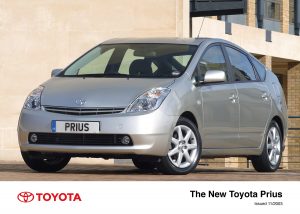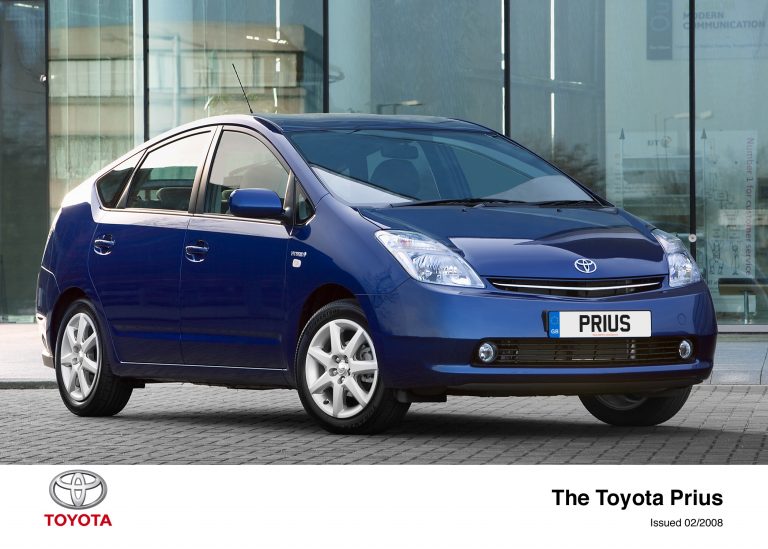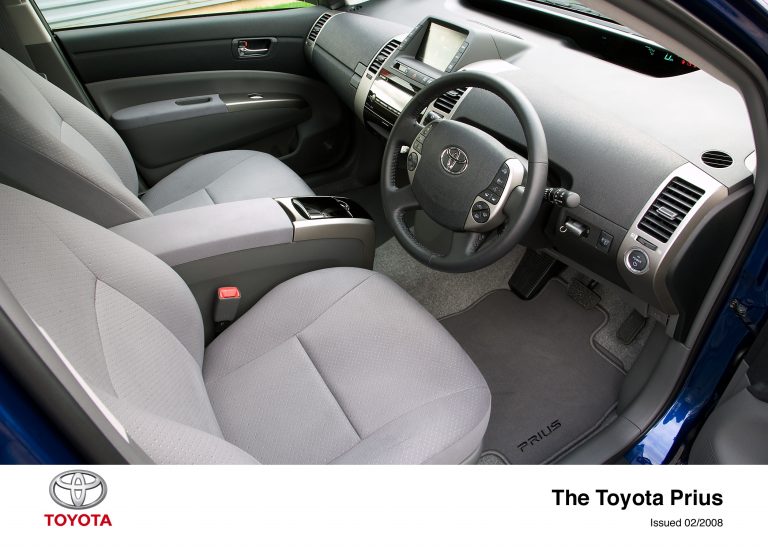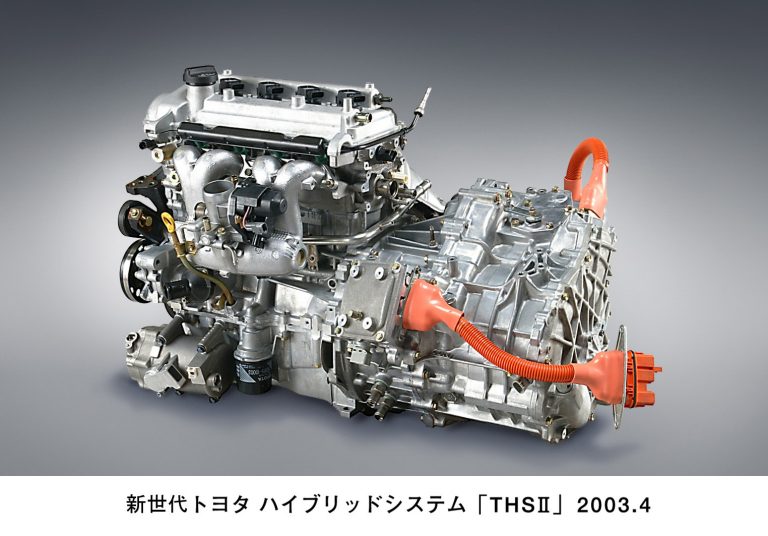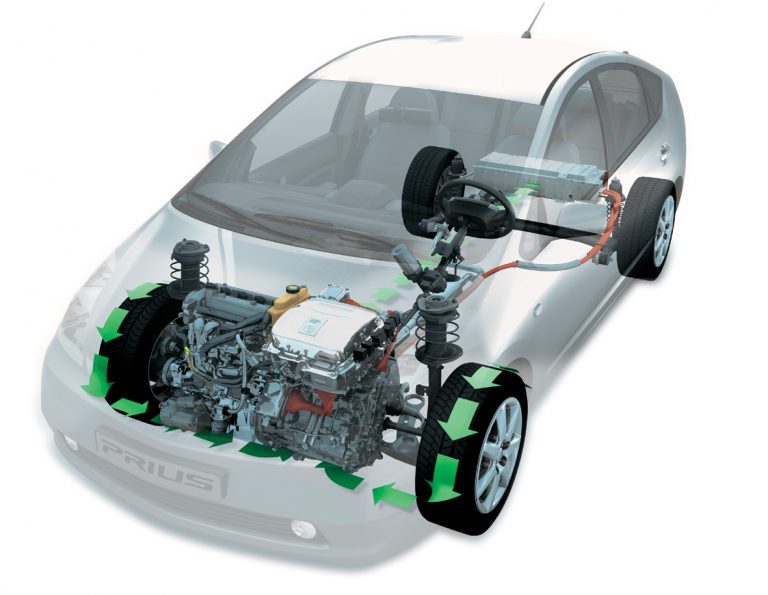Toyota Prius Paves The Way Ahead
Key points
- The world’s cleanest family car
- 65.7mpg combined fuel consumption with 0-62mph in 10.9 seconds
- Prius is the world’s first and most successful hybrid power vehicle, more than 130,000 sold worldwide since 1997
- New generation Prius launches ultra clean and efficient Toyota Hybrid Synergy Drive
- New Prius is D segment car with fuel economy to rival B segment diesels
- Single body style – five-door, five-seat hatchback
- 104g/km CO2 emissions, band AA for Vehicle Excise Duty
- Available in the UK in three grades – T3, T4 and T Spirit
- All grades feature eight airbags, ABS, Electronic Brakeforce Distribution (EBD), Brake Assist (BA), Electronic Traction Control (E-TRC) and Vehicle Stability Control Plus (VSC+)
- T4 models feature nine-speaker JBL premium audio with six-disc CD autochanger, cruise control and fog lamps
- T Spirit models add Bluetooth® telephone interface and DVD-based full-map satellite navigation, with voice recognition and touch screen controls
- Up to 16 functions, including audio, ventilation and communications controls, all positioned on the steering wheel for safer operation
- Advanced electric air conditioning system causes no loss in performance or fuel efficiency
- On sale in the UK 2 January
- On the road prices are £17,495 for T3, £18,295 for T4 and £19,995 for T Spirit grade (all excluding £1,000 Powershift grant from Energy Savings Trust)
- Insurance groups 7E (T3 and T4) and 8E (T Spirit)
SHORT STORY
Six years after the launch of the original Prius and with more than 130,000 examples sold worldwide, Toyota is unveiling an even more advanced version of the world’s most successful hybrid power car.
The second generation Prius is a blend of futuristic design and technology that delivers
D-segment levels of space, comfort and performance with B-class economy to today’s motorists.
With its unique and advanced Toyota Hybrid Synergy Drive®, the latest Prius is the cleanest car currently available to the motoring public and successfully demonstrates that being ‘green’ does not equate to dull performance or compromised packaging.
PERFORMANCE, ECONOMY AND LOW EMISSIONS
The new Toyota Prius can return a fuel consumption that is comparable to the best B-segment diesels. Production of CO2 and NOx is also radically low, while particulate matter emissions are non-existent. Figures for consumption are 65.7mpg for combined and 67.3mpg for extra-urban driving. In the urban cycle, Prius returns 56.5mpg, which beats every B-segment car on the market by a large margin. At the same time, this D-segment car can accelerate from nought to 62mph in less than 11 seconds.
The new Prius largely surpasses EURO IV emission standards. Hydrocarbon and nitrogen oxides emissions are respectively 80 and 87.5 per cent lower than required by EURO IV regulations for petrol engines. Furthermore, at a time when most diesel engines on the market don’t even comply with EURO IV, Prius NOx emissions are 96 per cent below the EURO IV level for diesel cars. In addition, Prius produces only 104g/km of CO2 exhaust emissions (on the combined cycle), and breaks the 100g/km barrier on the extra-urban cycle (99g/km).
The new hybrid system, making its debut in the Toyota Prius, is the first to be developed according to a revolutionary concept, Hybrid Synergy Drive®. Current generation hybrids rely on the petrol engine to produce peak performance, with the electric motor as an ancillary. Toyota Hybrid Synergy Drive® gives the electric motor a more significant role and also focuses on stronger performance.
A more powerful 1.5-litre petrol engine works together with the smaller, more efficient electric motor to deliver performance that positions the Prius as a serious contender in the D-segment. The electric motor is now more powerful than most 1.0 to 1.2-litre internal combustion engines and, at 400Nm from nought to 1,200rpm, the Prius’s torque surpasses that of modern V6 diesels. As a result, nought to 62mph is accomplished in less than 11 seconds, making Prius almost three seconds faster than the first generation model and comparable to a conventional 2.0-litre diesel engine.
REGENERATIVE BRAKING SYSTEM
In a conventional car, each time the brakes are applied to slow down, kinetic energy is wasted. Not so in the Prius, as this energy is captured and fed back into the battery as electrical energy to keep the battery fully charged. This is particularly useful during city stop-start driving.
Under braking the electric motor operates as a generator converting the vehicle’s kinetic energy into electricity, which is used to keep the battery fully charged. Each time the footbrake is applied the system controls the coordination between the hydraulic brake, the Electronically Controlled Brake System (ECB) and the regenerative brake to preferentially use regenerative braking, thereby recovering energy even at very low vehicle speeds. ECB (a brake-by-wire system) also brings a huge improvement in terms of regenerative braking performance.
STOP-GO SYSTEM
When a Prius has to stop at a traffic light or in a traffic jam, the petrol engine is automatically turned off in order to save energy. This also has a positive impact on fuel consumption. If prompt acceleration is needed when moving away from stationary, the petrol engine will automatically intervene to deliver maximum performance smoothly.
LONG HERITAGE OF TOYOTA HYBRID POWER
Toyota might have hit the headlines when it launched the original Prius to world acclaim in 1997, but its credentials in developing sustainable transport stretch back nearly 40 years to 1965 when it started investigating the feasibility of using gas turbines to power an electric drive system for cars.
In 1977, Toyota showcased its futuristic thinking than in the Sports 800 gas turbine hybrid. By using a performance-orientated sports car, Toyota demonstrated an imaginative approach to the question of environmentalism, creating a concept that would evolve into today’s Hybrid Synergy Drive®.
Twenty years later, Toyota unveiled a production hybrid bus, the Coaster, and the world-beating Prius, the first production hybrid car. Prius broke new ground in delivering ultra low emissions in urban conditions and an unlimited driving range and employing a regenerative braking system that recycled unwanted energy back into the car’s storage batteries. Since then Toyota has also launched the word’s first four-wheel drive hybrid – the Estima – and a mild hybrid version of its Crown saloon, as well as an experimental fuel cell vehicle.
STYLISH AND EFFICIENT DESIGN
The Prius takes full advantage of the latest lightweight materials technology. Everything from the bodyshell to the accelerator has been subjected to a weight-loss programme since less mass to haul around helps reduce fuel consumption and emissions as well as enhance vehicle performance.
And while the Prius is on the move its class-leading Cd figure of 0.26 ensures that it cleaves the air with minimum resistance, another weapon in the impressive Prius armoury against emissions and fuel consumption. The clean, aerodynamic design also cuts down wind noise, giving driver and passengers a quieter ride.
The new Prius is a full-size D-segment vehicle with ample space for driver and up to five passengers plus their luggage. While the new car is instantly recognisable as an evolution of the original Prius, at 4,450mm it is 135mm longer than its predecessor, and has a wheelbase longer by 150mm at 2,700mm.
The interior features rear seats that fold flat and have a 60:40 split. The front seats have a 575mm class-leading hip-point height, which not only makes getting in and out easier, but also provides the driver with a higher driving position for good all-round visibility. Toyota’s designers have paid special attention to the cabin’s interior ergonomics with the innovative use of design features and technologies such as Bluetooth® telephone interface and the location of many controls on the steering wheel.
By adopting the new Toyota Hybrid Synergy Drive® and reducing vehicle weight, the new Prius has achieved a 15 per cent reduction in fuel consumption, compared with the previous model.
PIONEERING NEW TECHNOLOGIES
Fully electric operation
For the first time in a hybrid car, the driver can use the EV (Electric Vehicle) driving mode simply by pressing a button on the dashboard. This allows the exclusive use of the electric motor to power the vehicle, producing zero emissions and very low noise – ideal when city commuting. The EV driving mode can be used for up to 1.25 miles with a maximum speed of 30mph.
Electric air conditioning
The Prius is the first production car to adopt an all-electric air-conditioning system. It is equipped with an electric-inverter compressor driven by an alternating current provided by the A/C inverter, which is built into the inverter of the hybrid system. As a result, the air conditioning system operates independently of the engine, so helping to reduce fuel
consumption. A humidity sensor function has been added to the system’s room temperature sensor in order to optimise the amount of dehumidification effort during operation. A compact, lightweight, and highly efficient electrical water pump has also been adopted, to ensure proper heater performance while the engine is stopped.
Drive-by-wire functions
Many of the new technologies used in the Prius – some unique to the car and world firsts – have been made possible by Toyota’s bold move to redefine the vehicle’s powertrain and electrical architecture. The higher voltages created by the batteries and converter have enabled Toyota’s engineers to equip the Prius with a far larger suite of ‘drive-by-wire’ technologies than has previously been seen in any production car. Throttle, transmission and braking are all electronically controlled and free of the traditional mechanical linkages.
Braking and body control systems
ABS, EBD (Electronic Brakeforce Distribution) and a new version of the Vehicle Stability Control system, called VSC+, operate through an electric/electronic circuit. A central electronic brain, the Skid Control ECU, co-ordinates all these systems to create perfect synergy between them. The VSC+ works in conjunction with the electric power steering system in emergency situations, making it possible to improve vehicle reaction times and so help avoid or minimise the impact of accidents.
Voice recognition
New Prius benefits from voice recognition functions for the audio system, air conditioning and satellite navigation, letting the driver keep his or her attention on the road instead of having to adjust control buttons. The system has been designed to respond to an extensive command list. The versatility of the navigation system, fitted as standard to the T Spirit model, allows it to react immediately to commands: for example, the spoken command “hotel” will produce a list of hotels in the neighbourhood, to which a route can be automatically programmed.
Driver distraction is further reduced by the location of more control functions on the steering wheel than ever before. Sixteen functions for audio, ventilation, voice recognition activation and, where fitted, telephone systems are all positioned on the steering wheel pad, right in front of the driver.
UK GRADE STRUCTURE
The new Prius moves from a single model range to offer three distinct grades in the UK market: T3, T4 and T Spirit.
The entry-level T3 grade offers a comprehensive inventory of safety, comfort and convenience features. The active and passive safety package includes front and side airbags and front and rear curtain airbags, front seatbelts with pretensioners and load limiters, ABS with Electronic Brakeforce Distribution (EBD) and Brake Assist (BA), Electronic Traction Control (E-TRC) and Vehicle Stability Control Plus (VSC+).
All Prius come with a sophisticated electric climate control system, electric front and rear windows and door mirrors, remote central door locking, electric power steering, immobiliser with alarm, 60:40 split-folding rear seats, height adjustable driver’s seat, tilt-adjustable steering wheel six-speaker sound system with single disc CD player and controls for audio, ventilation and trip information mounted conveniently on the steering wheel pad.
The T4 grade adds front fog lamps, cruise control and a premium JBL audio system with six-disc CD autochanger, while the T Spirit benefits from additional DVD-based full-map satellite navigation with voice recognition and Bluetooth® telephone interface.
COMPETITIVE ON THE ROAD PRICING
The new Toyota Prius is priced to rival the best of the D-segment diesel market. The T3 entry level model has an OTR price of £17,495, but qualifies – along with all other Prius models – for a £1,000 grant under the Government’s Energy Savings Trust Powershift scheme, bringing the cost to the customer down to £16,495.
Taking the Prius T3’s comprehensive specification of safety, comfort and convenience features into account, it works at better value for money than its established, high volume competitors. Balanced against the OTR price and specification of equivalent Vauxhall Vectra, Renault Laguna and Ford Mondeo models, the Prius works out anything up to 7.8 per cent better value. And that is before you factor in the lower running costs achievable thanks to the car’s fuel efficiency, servicing requirements and the cost of replacement parts.
Full details of how the new Prius competes on pricing against key rivals is provided in the table below (prices correct at the time of writing).
TOYOTA PRIUS COMPETITOR PRICE COMPARISON
|
TOYOTA PRIUS T3 |
VAUXHALL VECTRA SXi 2.0 TDi |
RENAULT LAGUNA DYNAMIQUE 1.9 DCi |
FORD MONDEO ZETEC 2.0 TDCi |
|
|
On the road price |
£17,495 |
£16,845 |
£17,075 |
£17,300 |
|
PowerShift grant |
(£1,000) |
– |
– |
– |
|
Adjusted price |
£16,495 |
£16.845 |
£17,075 |
£17,300 |
| SPECIFICATION | ||||
|
Air conditioning |
ü |
ü |
ü |
ü |
|
Climate control |
ü |
û |
û |
ü |
|
Electric front windows |
ü |
ü |
ü |
ü |
|
Electric rear windows |
ü |
û |
ü |
ü |
|
Electric door mirrors |
ü |
ü |
ü |
ü |
|
CD player |
ü |
ü |
ü |
ü |
|
Steering wheel audio controls |
ü |
ü |
ü |
ü |
|
Leather steering wheel trim |
û |
ü |
ü |
ü |
|
Rear spoiler |
ü |
û |
ü |
û |
|
Front reading lights |
ü |
û |
ü |
û |
|
Illuminated vanity mirrors |
ü |
û |
ü |
ü |
|
Fuel consumption computer |
ü |
û |
ü |
ü |
|
60:40 split-folding rear seats |
ü |
ü |
ü |
ü |
|
ABS with EBD and Brake Assist |
ü |
ü |
ü |
ü |
|
Cruise control |
û |
ü |
û |
ü |
|
Front fog lights |
û |
ü |
ü |
ü |
| Driver & passenger front airbags |
ü |
ü |
ü |
ü |
|
Front side airbags |
ü |
ü |
ü |
ü |
|
Front and rear curtain airbags |
ü |
ü |
ü |
ü |
|
Electronic traction control |
ü |
ü |
û |
û |
|
Vehicle stability control |
ü |
û |
û |
û |
|
Alarm system |
ü |
ü |
ü |
ü |
|
Sunroof |
û |
û |
ü |
û |
|
Specification adjustment |
– |
£685 |
£700 |
£430 |
|
Specification adjusted price |
£16,495 |
£17,530 |
£17,775 |
£17,730 |
| Percentage difference |
– |
+6.3 |
+7.8 |
+7.5 |
LOW MAINTENANCE AND REPAIR COSTS
Although the new Prius boasts more advanced technology features than any other car in its class, there is no penalty for owners in terms of its servicing schedule or the cost of maintenance and crash replacement parts.
Taking the price of like-for-like components, the new Prius is actually cheaper overall to maintain and repair than many of its key market rivals – its stablemate, the new Toyota Avensis, being the notable exception.
Calculating the collective price of front and rear body parts commonly replaced following a collision, such as wings, bonnet and bumpers, the bill for the new Prius is up to £762 cheaper than the most popular D-segment models. On maintenance items, such as filters and brake pads, the combined cost works at up to £35 less than the competition.
More than that, the Prius’s advanced powertrain does not call for more frequent servicing. In common with all contemporary Toyota passenger cars, the maintenance programme requires a major service only every 20,000 miles, with interim “health and safety” checks with oil change every 10,000 miles.
Further peace of mind is provided by the eight-year/100,000-mile warranty on all the Prius’s hybrid components.
Full details of how the new Prius measures up against its main segment rivals in terms of repair and maintenance costs are provided in the table below.
NEW PRIUS COMPETITOR COMPARISONS
|
NEW PRIUS |
TOYOTA AVENSIS |
RENAULT LAGUNA |
VOLKSWAGEN PASSAT |
FORD MONDEO |
VAUXHALL VECTRA |
MAZDA 6 |
|
| FRONT CRASH PARTS | |||||||
|
Bonnet |
£119.51 |
£118.88 |
£197.00 |
£142.81 |
£139.86 |
£198.00 |
£145.36 |
|
Radiator grille |
£0.00 |
£63.31 |
£42.60 |
£46.44 |
£57.93 |
£34.11 |
£37.29 |
|
Front bumper |
£106.90 |
£94.54 |
£200.00 |
£167.65 |
£99.30 |
£195.00 |
£138.96 |
|
Front wing |
£97.88 |
£79.79 |
£84.00 |
£85.00 |
£76.41 |
£84.00 |
£78.85 |
|
Headlamp (excl. bulb) |
£78.91 |
£95.23 |
£112.00 |
£199.00 |
£102.50 |
£123.00 |
£94.06 |
|
Radiator |
£162.53 |
£149.26 |
£220.00 |
£127.69 |
£200.26 |
£151.00 |
£137.36 |
|
A/C condenser |
£230.99 |
£199.38 |
£431.00 |
£321.00 |
£192.42 |
£164.00 |
£163.81 |
|
Total front |
£796.73 |
£800.39 |
£1,286.60 |
£1,089.59 |
£868.68 |
£949.11 |
£795.69 |
|
Percentage difference |
– |
+0.5 |
+61.5 |
+36.8 |
+9.0 |
+19.1 |
(0.1) |
| REAR CRASH PARTS | |||||||
|
Rear bumper |
£106.90 |
£86.66 |
£182.00 |
£265.93 |
£99.30 |
£184.00 |
£148.27 |
|
Tailgate |
£184.42 |
£168.95 |
£240.00 |
£149.00 |
£188.67 |
£192.98 |
£187.00 |
|
Rear quarter panel |
£135.41 |
£130.47 |
£269.00 |
£187.34 |
£95.91 |
£132.10 |
£185.14 |
|
Rear lamp cluster (excl. bulbs) |
£72.87 |
£42.92 |
£80.80 |
£57.00 |
£46.96 |
£48.20 |
£45.62 |
|
Total rear |
£499.61 |
£429.00 |
£771.80 |
£659.27 |
£430.84 |
£557.28 |
£566.03 |
|
Percentage difference |
(14.1) |
+54.5 |
+32.0 |
(13.8) |
+11.5 |
+13.3 |
|
|
Total front & rear |
£1,296.33 |
£1,229.39 |
£2,058.40 |
£1,748.86 |
£1,299.52 |
£1,506.39 |
£1,361.72 |
|
Percentage difference |
(5.2) |
+58.8 |
+34.9 |
+0.2 |
+16.2 |
+5.0 |
|
|
MAINTENANCE PARTS |
|||||||
|
Oil filter |
£7.00 |
£7.00 |
£6.20 |
£5.73 |
£5.17 |
£8.35 |
£7.10 |
|
Air filter |
£12.40 |
£11.00 |
£14.95 |
£13.00 |
£11.27 |
£6.35 |
£14.27 |
|
Front brake pads |
£33.02 |
£42.59 |
£36.30 |
£59.00 |
£50.95 |
£46.85 |
£59.98 |
|
Rear brake pads/shoes |
£36.04 |
£26.01 |
£45.00 |
£34.00 |
£57.99 |
£27.05 |
£41.10 |
|
Total maintenance |
£88.46 |
£99.85 |
£102.45 |
£111.73 |
£125.38 |
£88.60 |
£122.45 |
|
Percentage difference |
+12.9 |
+15.8 |
+26.3 |
+41.7 |
+0.2 |
+38.4 |
|
|
Grand total |
£1,384.79 |
£1,329.24 |
£2,160.85 |
£1,860.59 |
£1,424.90 |
£1,594.99 |
£1,484.17 |
|
Percentage difference |
(4.0) |
+56.0 |
+34.4 |
+2.9 |
+15.2 |
+7.2 |
All prices are recommended retail, exclude VAT and are correct at the time of printing (November 2003).
Source: Statagem Marketing and Business Services
TARGET BUYER PROFILE
Potential customers for the second generation Prius are seen as ‘early adopters’ rather than the ‘innovators’ who bought the original model.
Typical ‘early adopters’ are in their 40s, predominantly male, professionals or executives with a higher level of education and above average income, usually living and/or working in metropolitan areas. These are the same sort of individuals who would typically use Bluetooth® technology and the latest electronic personal organisers as part of their daily working and social lives. They also have a socio-environmental conscience, but still want to enjoy their driving and might currently drive one of the sporty diesel cars in the D-segment or small-premium sector. They are interested in low fuel consumption and low emissions and are willing to pay extra for these benefits because of their reduced impact on the environment
Moreover, with congestion charging now a reality in London – and likely to spread to other cities in the UK and Europe – these ‘early adopters’ are looking for ways to avoid these fees. Cars like the Prius are currently exempt from London’s congestion charge. The new Toyota Prius goes on sale in the UK on 2 January 2004.
PRIUS TECHNICAL SPECIFICATIONS
|
ENGINE |
||
|
Type |
4-cylinder in-line, high expansion cycle |
|
|
Valve mechanism |
16-valve DOHC VVT-i |
|
|
Fuel system |
Electronic Fuel Injection |
|
|
Fuel type |
95 octane petrol (or higher) |
|
|
Bore x Stroke (mm) |
75.0 x 84.7 |
|
|
Displacement (cc) |
1,497 |
|
|
Compression ratio |
13.0:1 |
|
|
Max. power (bhp/rpm) |
76 @ 5,000 |
|
|
Max. torque (Nm/rpm) |
115 @ 4,000 |
|
|
MOTOR |
||
|
Type |
Synchronous, permanent magnet |
|
|
Rated voltage |
500 |
|
|
Max. power (bhp/rpm) |
67 @ 1,200-1,540 |
|
|
Max. torque (Nm/rpm) |
400 @ 0-1,200 |
|
|
BATTERY |
||
|
Type |
Sealed nickel – metal hydride |
|
|
Nominal voltage |
201.6 |
|
|
Modules |
28 modules with 6 cells joined together |
|
|
Linkage |
Series |
|
|
Capacity Ah (hrs) |
6.5 (3h) |
|
|
HYBRID POWERTRAIN |
||
|
Type |
Serial-parallel |
|
|
Torque transfer type |
Planetary gear unit |
|
|
PERFORMANCE |
||
|
0-62mph (sec) |
10.9 |
|
|
Max.speed (mph) |
106 |
|
|
FUEL CONSUMPTION (99/100 EC) |
||
|
Combined (mpg) |
65.7 |
|
|
Extra Urban (mpg) |
67.3 |
|
|
Urban (mpg) |
56.5 |
|
|
Emission Compliance Level |
Euro 4 |
|
|
Fuel tank capacity (L) |
45 |
|
|
VED Band |
AA |
|
|
CO2 g/km |
104 |
|
|
DIMENSIONS |
||
|
Overall length (mm) |
4,450 |
|
|
Overall width (mm) |
1,725 |
|
|
Overall height (mm) |
1,490 |
|
|
Wheelbase (mm) |
2,700 |
|
|
Tread width (mm) front |
1,510 |
|
|
Tread width (mm) rear |
1,480 |
|
|
Overhang (mm) front |
890 |
|
|
Overhang (mm) rear |
860 |
|
|
Coefficient of Drag |
0.26 |
|
|
Minimum turning radius (m) |
5.1 |
|
|
Luggage compartment (L) |
408 |
|
|
WEIGHTS (kg) |
||
|
Gross vehicle weight |
1,725 |
|
|
Kerb weight |
1,300 |
|
|
SUSPENSION |
||
|
Front |
MacPherson strut with stabiliser bar |
|
|
Rear |
Torsion beam with stabiliser bar |
|
|
BRAKES |
||
|
Front |
225mm ventilated disc, with regenerative brake system |
|
|
Rear |
269mm solid disc |
|
|
STEERING |
||
|
Type |
Rack and pinion, electric power steering |
|
|
Ratio |
19.1:1 |
|
|
Turns (lock to lock) |
3.61 |
|
|
TYRES AND WHEELS |
||
|
Wheel size |
16″x6JJ aluminium |
|
|
Tyre size |
195/55 R16 |
|
ENDS

